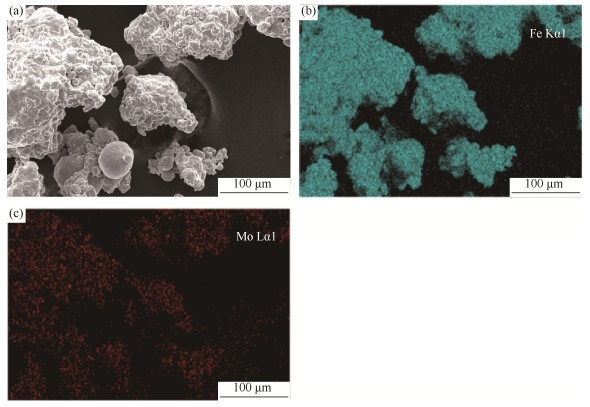Effect of forging temperature on microstructure and mechanical properties of powder hot-forged alloy contained molybdenum
-
摘要: 采用粉末热锻工艺制备Fe-1C-2Cu-xMo (x=0.50, 0.85, 1.46, 质量分数)合金, 分析锻造温度和Mo质量分数对烧结态及锻造态合金密度、显微组织、静态力学性能和动态摩擦性能的影响。结果表明: 锻造工艺能够有效提高材料密度, 锻后合金相对密度可达到98.5%, 锻态合金组织主要由贝氏体、马氏体和残余奥氏体组成。合金硬度随Mo质量分数的增加而提高, 随锻造温度的升高先降低后提高, 1050 ℃锻造Fe-1C-2Cu-1.46Mo合金硬度可达HRB116.38。Mo质量分数和锻造温度共同影响合金横向断裂强度, 1000 ℃锻造Fe-1C-2Cu-0.50Mo合金强度最高可达2608MPa, 合金断裂方式为韧脆混合型断裂。材料动态摩擦性能随Mo质量分数的增加显著提升, 当锻造温度为950 ℃且Mo质量分数为1.46%时, 材料的摩擦系数仅为0.088, 明显低于其他材料且波动较小。Abstract: Fe-1C-2Cu-xMo (x=0.50, 0.85, 1.46, mass fraction) alloys were fabricated by powder hot-forging in this paper. The effect of forging temperature and Mo content by mass on the density, microstructure, static mechanical properties, and dynamic friction properties of the alloys were investigated. In the results, the forging can effectively increase the density of alloys, and the relative density can reach 98.5% after forging. The microstructure is mainly composed of bainite, martensite, and retained austensite. The hardness of alloys increases with the increase of Mo content, and decreases first and then increases with the increase of forging temperature. The hardness of Fe-1C-2Cu-1.46Mo alloys forged at 1050 ℃ reaches the maximum value of HRB 116.38. The transverse rupture strength is jointly affected by the Mo content by mass and forging temperature, the maximum strength of Fe-1C-2Cu-0.50Mo alloys forged at 1000 ℃ can reaches 2608 MPa, and the fracture mode of alloys is the mixture of ductile and brittle fracture. As the increase of Mo content, the dynamic friction properties increase significantly. The friction coefficient of Fe-1C-2Cu-1.46Mo alloys forged at 950 ℃ is only 0.088, which is obviously lower than that of others with the smaller fluctuation.
-
表 1 原料粉体纯度及粒度
Table 1. Purity and particle sizes of the raw powders
原料粉体 纯度(质量分数) /% 粒度/μm Mo预合金 ≥99.9% ≤150.0 Cu ≥99.9% ≤75.0 石墨 ≥99.9% ≤6.5 表 2 Fe-1C-2Cu-xMo合金化学成分(质量分数)
Table 2. Chemical composition of the Fe-1C-2Cu-xMo alloys
% 试样编号 Mo Cu C M1 0.50 2.00 1.00 M2 0.85 2.00 1.00 M3 1.46 2.00 1.00 表 3 合金烧结态及锻态密度
Table 3. Density of the sintered and forged alloys
成分 烧结态密度/(g·cm‒3) 锻态密度/(g·cm‒3) 900 ℃ 950 ℃ 1000 ℃ 1050 ℃ M1 6.50 (82.3%) 7.74 (98.0%) 7.77 (98.4%) 7.76 (98.2%) 7.75 (98.1%) M2 6.50 (82.2%) 7.73 (97.7%) 7.76 (98.2%) 7.75 (98.0%) 7.73 (97.7%) M3 6.51 (82.2%) 7.73 (97.6%) 7.79 (98.5%) 7.76 (98.0%) 7.75 (97.9%) 注:括号中为对应的相对密度 表 4 1000 ℃锻造态M3合金元素能谱成分分析
Table 4. Composition of the M3 alloy samples forged at 1000 ℃ in EDS analysis
位置 元素质量分数/% Cu Mo 1 2.28 1.39 2 2.05 1.35 3 1.97 1.27 -
[1] Wang C L, Jia P H, Li Z X. Mechanical Properties of Powder Forged Low-Alloy Steels. 1st Ed. Freiburg: Verlag Schmid Gmbh, 1986 [2] Zeng H Z, Li Z Y, Zhang L, et al. Effect of Mn content on the microstructure and mechanical propoties of Fe-Cu-C sintered low-alloy steels. Mater Sci Eng Powder Metall, 2016, 21(4): 658 doi: 10.3969/j.issn.1673-0224.2016.04.022曾海卒, 李志友, 张雷, 等. Mn含量对粉末冶金铁碳铜低合金钢组织与力学性能的影响. 粉末冶金材料科学与工程, 2016, 21(4): 658 doi: 10.3969/j.issn.1673-0224.2016.04.022 [3] Hu L, Xiao Z Y, Fu W C, et al. Effect of manganese content on microstructure and properties of Fe-Cu-Mn-C sintering alloy. Mater Sci Eng Powder Metall, 2013, 18(6): 821 doi: 10.3969/j.issn.1673-0224.2013.06.008胡磊, 肖志瑜, 付文超, 等. Mn含量对Fe-Cu-Mn-C系烧结合金组织和性能的影响. 粉末冶金材料科学与工程, 2013, 18(6): 821 doi: 10.3969/j.issn.1673-0224.2013.06.008 [4] Guo B, Ge C C, Zhang S C, et al. Powder forging techonlogy and its application progress. Powder Metall Ind, 2011, 21(3): 45 doi: 10.3969/j.issn.1006-6543.2011.03.010郭彪, 葛昌纯, 张随财, 等. 粉末锻造技术与应用进展. 粉末冶金工业, 2011, 21(3): 45 doi: 10.3969/j.issn.1006-6543.2011.03.010 [5] Engstrom U, Miligan D, Klekovkin A, et al. Efficient low-alloyed steels for high performance structural applications//Proceedings of the 2005 International Conference on Powder Metallurgy and Particulate Materials. Princeton, 2005: 233 [6] Zhou Y H, Hu P, Chang T, et al. Research progress of strengthening and toughening modes and mechanisms of molybdenum alloys. J Funct Mater, 2018, 49(1): 01026 https://www.cnki.com.cn/Article/CJFDTOTAL-GNCL201801006.htm周宇航, 胡平, 常恬, 等. 钼合金强韧化方式及机理研究进展. 功能材料, 2018, 49(1): 01026 https://www.cnki.com.cn/Article/CJFDTOTAL-GNCL201801006.htm [7] Šalak A, Selecka M. Manganese in Powder Metallurgy Steels. 1st Ed. London: Cambridge International Science Publishing, 2012 [8] Chen H Z, Li S L, Wang H, et al. Effect of small amount of Mo addition on microstructure and mechanical properties of Fe-0.5Mn-0.5C sintered steels. Mater Sci Eng Powder Metall, 2014, 19(5): 784 doi: 10.3969/j.issn.1673-0224.2014.05.018陈荟竹, 李松林, 王行, 等. 少量Mo添加对Fe-0.5Mn-0.5C烧结钢组织和力学性能的影响. 粉末冶金材料科学与工程, 2014, 19(5): 784 doi: 10.3969/j.issn.1673-0224.2014.05.018 [9] Bruce L. Development and benefits of prealloyed molybdenum PM steels. Int J Powder Metall, 2016, 52(3): 60 http://smartsearch.nstl.gov.cn/paper_detail.html?id=ffed005e5dc452dd598b0ee863d2de82 [10] King P, Patel S, Shah S, et al. Lower molybdenum steels for high performance powder metallurgy applications//Advance in Powder Metallurgy and Particulate Materials 2006. Princeton, 2006: 81 [11] Chen Q L. Research on the Related Factors of the Performance of Powder Hot Forging Parts[Dissertation]. Hefei: Hefei University of Technology, 2013陈其玲. 粉末热锻零件性能影响因素研究[学位论文]. 合肥: 合肥工业大学, 2013 [12] Rathore S S, Salve M M, Dabhade V V. Effect of molybdenum addition on the mechanical properties of sinter-forged Fe-Cu-C alloys. J Alloys Compd, 2015, 649: 988 doi: 10.1016/j.jallcom.2015.07.156 [13] Shanmugam S, Pandey K S, Thangal S U M, et al. Ring rupture strength and hardness of sintered hot-forged 1.5Mo alloyed carbon steels. J Mater Process Technol, 2009, 209(7): 3426 doi: 10.1016/j.jmatprotec.2008.07.043 [14] Yang S, Xiao Z Y, Guan H J, et al. Microstructure and mechancial properties of sintered and forged Fe-2Cu-0.5C-0.11S materials. Powder Metall Technol, 2017, 35(1): 23 doi: 10.3969/j.issn.1001-3784.2017.01.004杨硕, 肖志瑜, 关航健, 等. 烧结和锻造态Fe-2Cu-0.5C-0.11S材料的组织与力学性能研究. 粉末冶金技术, 2017, 35(1): 23 doi: 10.3969/j.issn.1001-3784.2017.01.004 [15] Sharif A A. Effect of Re and Al-alloying on mechanical properties and high-temperature oxidation of MoSi2. J Alloys Compd, 2012, 518: 22 doi: 10.1016/j.jallcom.2011.12.082 [16] Wang X T. Metal Material Science. 1st Ed. Beijing: China Machine Press, 1987王笑天. 金属材料学. 1版. 北京: 机械工业出版社, 1987 [17] Xu Z, Zhao L C. Metal Solid Phase Transition Principle. 1st Ed. Beijing: Science Press, 2004徐洲, 赵连城. 金属固态相变原理. 1版. 北京: 科学出版社, 2004 [18] Lei L L. Research on the Microstructure and Properties of Fe-Cr-Mo Powder Metallurgy Steel[Dissertation]. Changsha: Center South University, 2014雷龙林. Fe-Cr-Mo粉末冶金钢组织与性能的研究[学位论文]. 长沙: 中南大学, 2014 -




 下载:
下载:











